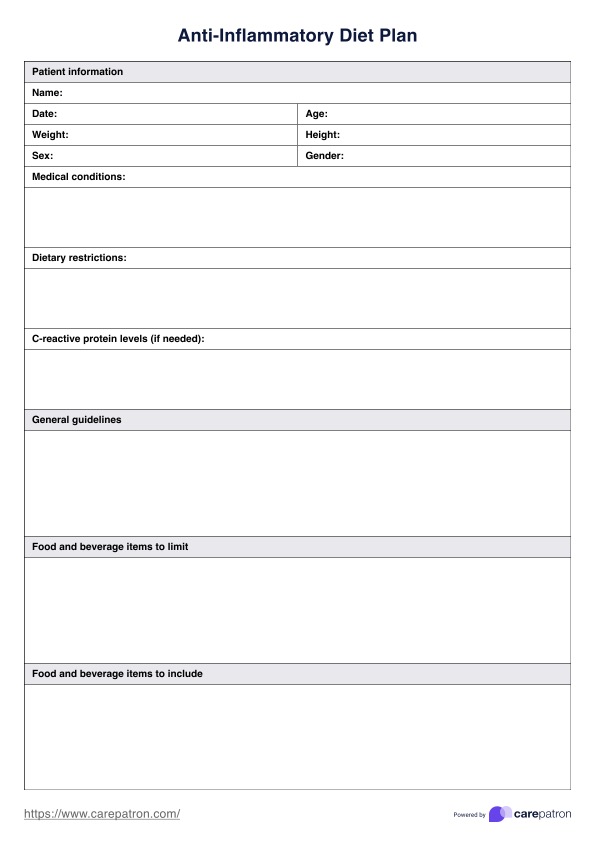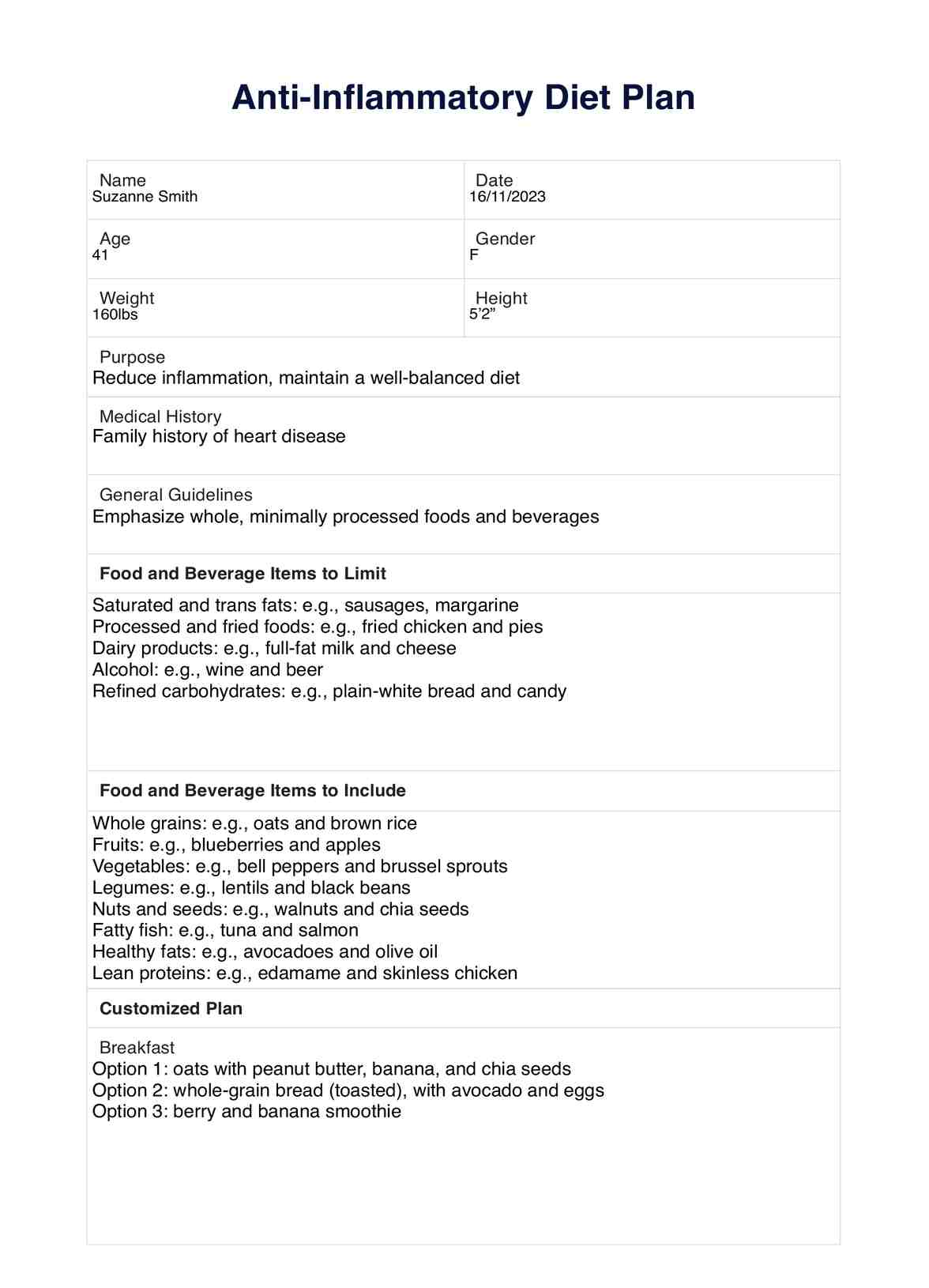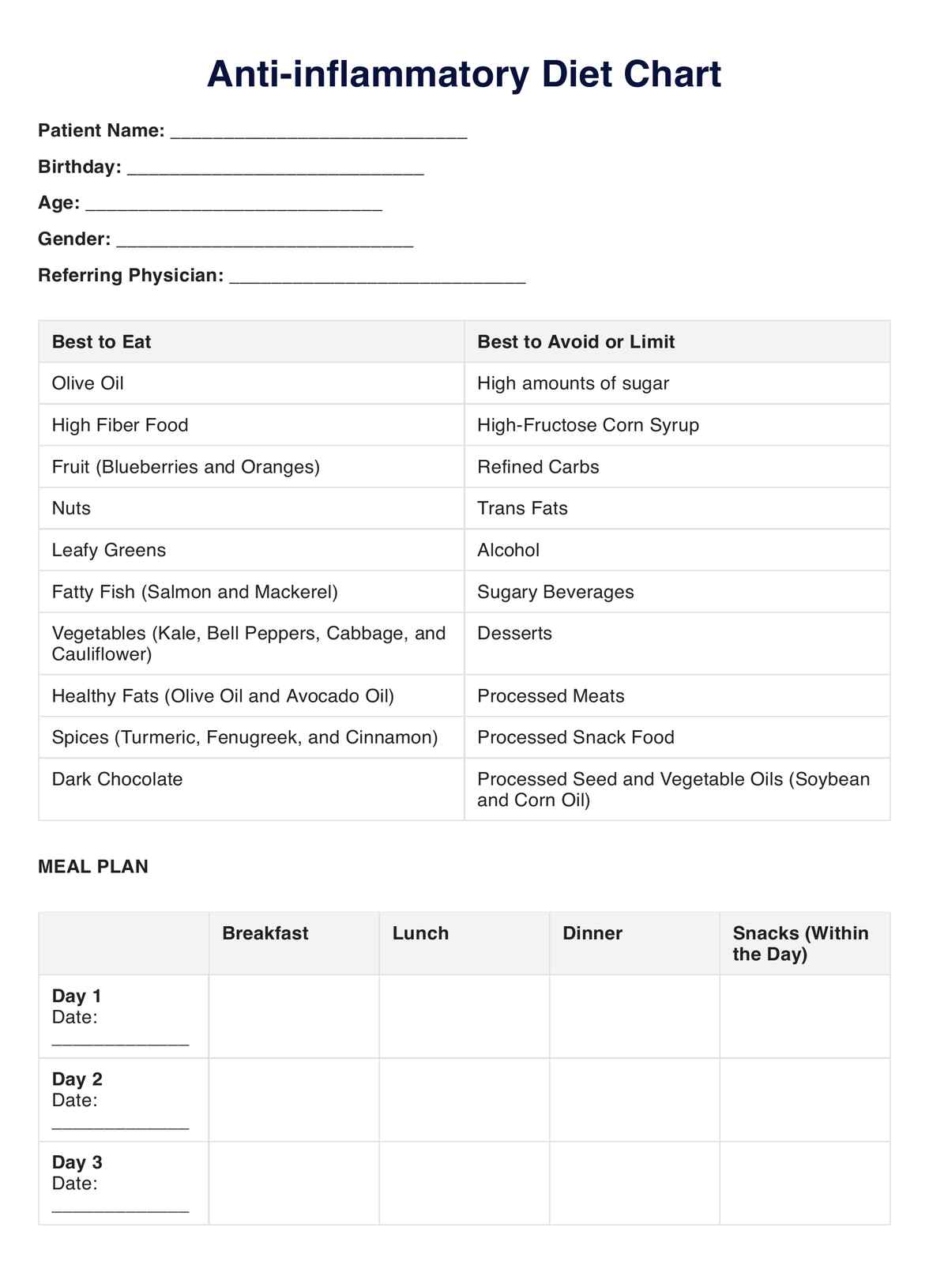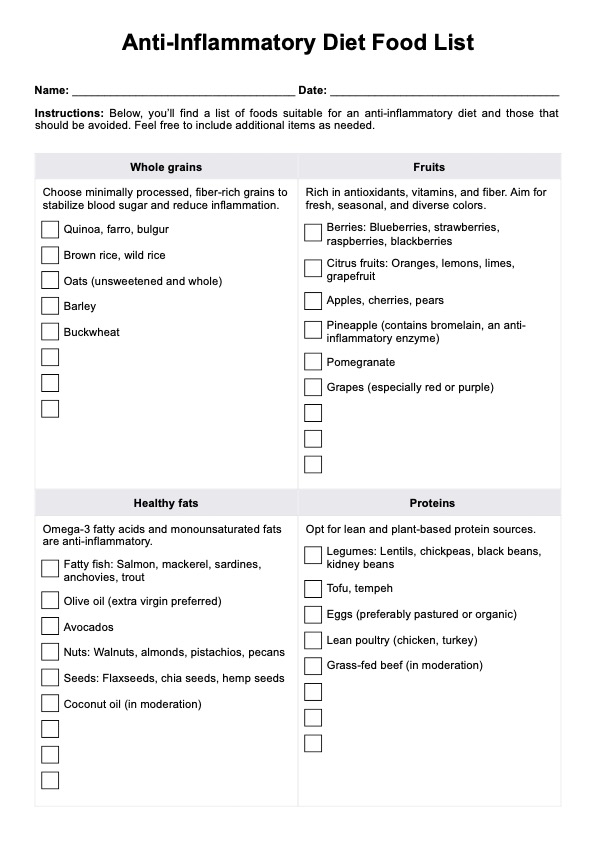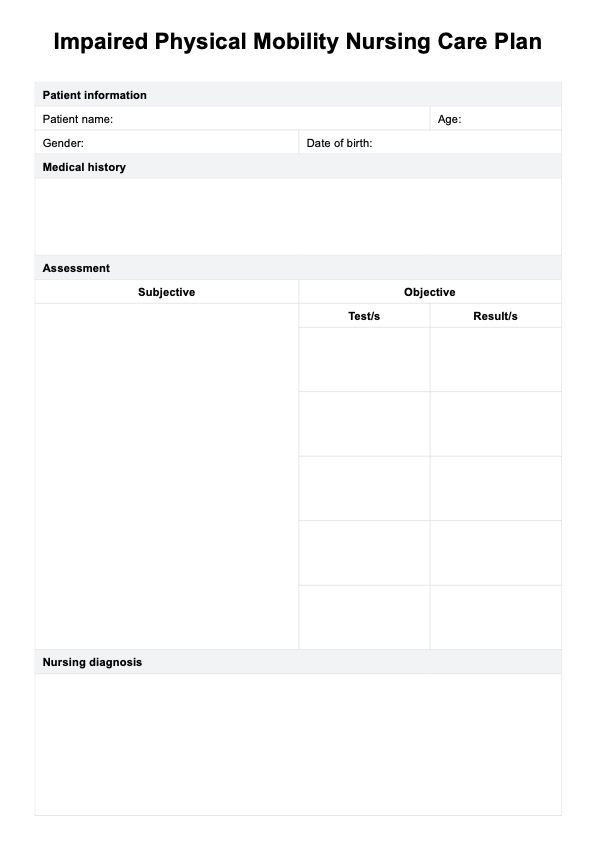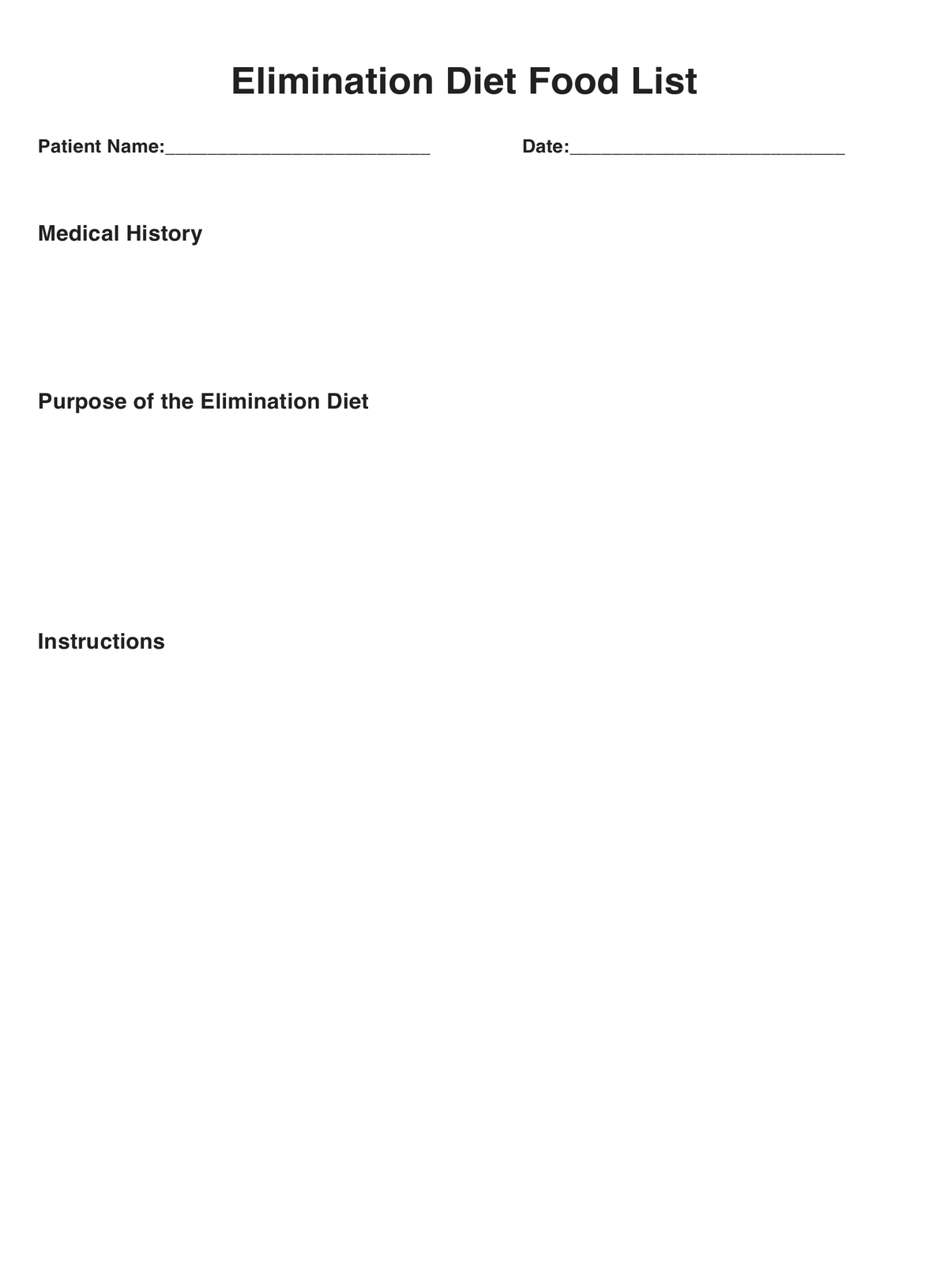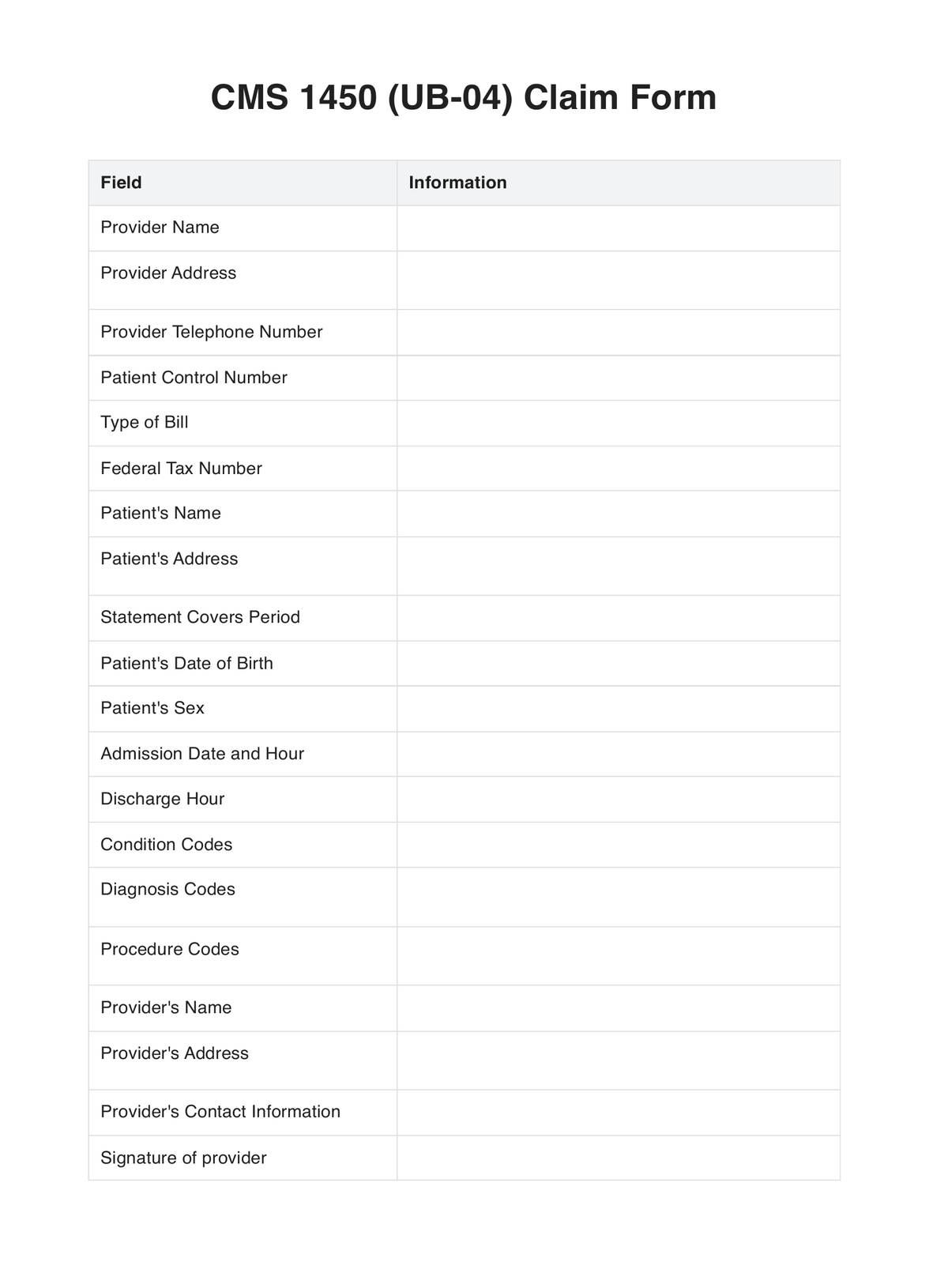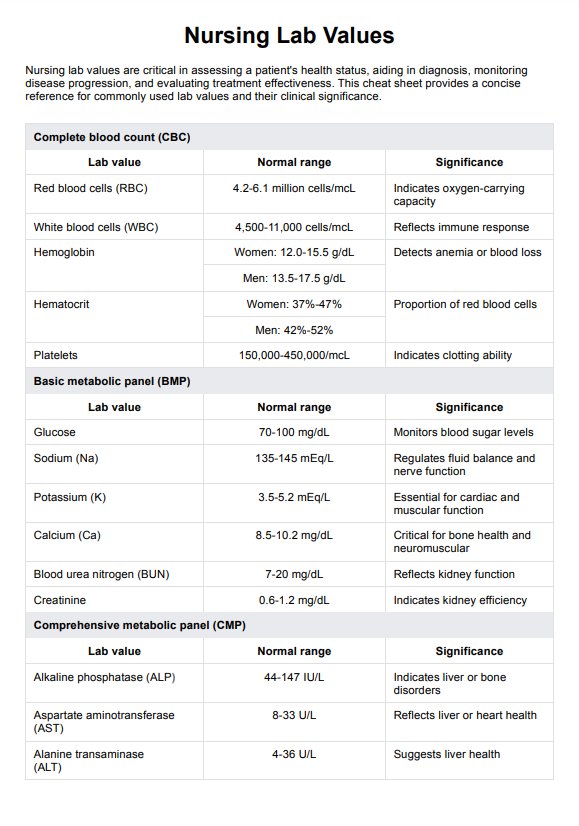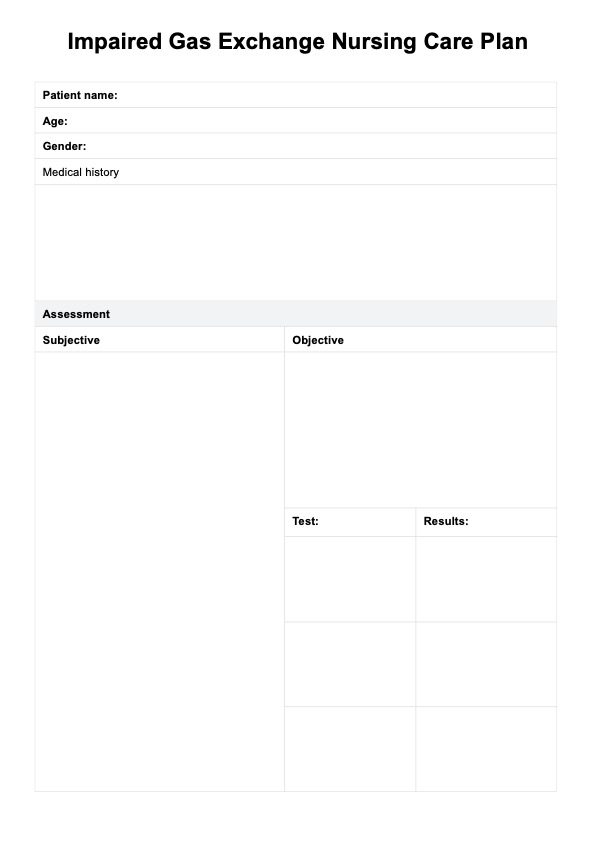Anti Inflammatory Diet Plan
Discover the benefits of an Anti Inflammatory Diet with our user-friendly, comprehensive guide, and get a free PDF download of an Anti Inflammatory Diet example to begin your wellness journey.


What is an Anti Inflammatory Diet Plan?
An Anti Inflammatory Diet is a nutritional plan designed to reduce the inflammatory molecules in the body to reduce inflammation, risks, and symptoms of chronic illnesses, and promote overall well-being.
The Anti Inflammatory Diet aims to enhance dietary management, introducing anti-inflammatory properties in the body to reduce the number of inflammatory radicals, which can help mitigate the symptoms, and risks of chronic inflammation (Wong, 2023). This dietary plan promotes a holistic approach to health and well-being, that allows individuals to achieve a well-balanced diet, primarily consisting of whole foods, without over-restriction or compromising their tastes or needs.
As a holistic approach to health, the Anti Inflammatory Diet Plan involves altering lifestyle behaviors to reduce inflammation, where it is recommended that individuals identify behaviors that may be causing inflammation, and adopt long-term habits to reduce this (University of Wisconsin, n.d.). This may involve:
- Consuming a well-balanced diet, focusing on anti-inflammatory foods
- Daily physical activity
- Limiting alcohol
- Not smoking
- Implementing stress-management strategies
- Prioritizing quality sleep
- Managing weight gain or weight loss
Implementing this diet plan involves the consumption of whole foods, prioritizing antioxidant fruits and vegetables, anti-inflammatory herbs and spices, and lean proteins. This subsequently reduces the intake of processed goods, like saturated fats, refined grains, and refined sugars.
The flexibility of the Anti Inflammatory Diet Plan means that there is no one way to follow it. Individuals can still prioritize their tastes and needs, as this diet plan provides recommendations for anti-inflammatory foods and beverages for daily consumption, while still allowing for occasional consumption of goods that may be more inflammatory. A typical rule of thumb is the 80/20 rule, where individuals aim to consume anti-inflammatory foods 80%, saving the other 20% from having things like wine and candy for special occasions (Hunter, 2019).
Individuals and healthcare practitioners, such as general practitioners and registered dieticians, can implement an Anti Inflammatory Diet to support well-balanced diets, that reduce chronic inflammation and enhance wellbeing.
Anti Inflammatory Diet Plan Template
Anti Inflammatory Diet Plan Example
How does it work?
Utilizing Carepatron’s Printable Anti Inflammatory Diet Plan can help you support your own, or a client’s journey to mitigating chronic inflammation, and enhancing health and well-being. It categorizes different food groups into anti-inflammatory and inflammatory food lists, from which individuals can tailor meals and snacks to specific dietary preferences with ease. Here’s how to use our template:
Step 1: Obtain the Anti Inflammatory Diet Plan
Access our Printable Anti Inflammatory Diet Plan here, or download the PDF copy to use as a reference. This can be a guide to use for anti-inflammatory foods to include in a daily diet, as well as which foods should be consumed on occasion.
Step 2: Client Consultation
Start entering the basic demographic and health information, including age, weight, height, gender, and any medical conditions or dietary restrictions they may have. You may also consider measuring C-reactive protein levels in the blood to test for the level of inflammation.
Step 3: Plan Meals and Snacks
After looking at the list of anti-inflammatory foods, list meals, and snack options for the week. In this step, make sure to include a variety of foods from different food groups, focus on incorporating foods with anti-inflammatory foods, and list the types of food and beverages recommended to have on occasion.
Step 4: Create a Grocery List
The Anti Inflammatory Diet Plan can also be used to write down the ingredients involved in the recipes for the planned meals and snacks. This can be a time-saver in the grocery store, and enhance adherence to the diet plan.
Step 5: Ongoing Monitoring and Support
Clients may like to keep a food diary to monitor any changes in inflammation, food preferences, or sensitivities that they may experience on their journey. This can help them keep track of their progress and also help find causes of inflammation from which they can gain further support and guidance from healthcare providers.
When would you use this Plan?
You can use this Anti Inflammatory Diet Plan to help manage inflammation, improve lifestyle behaviors, and enhance overall well-being through diet and lifestyle changes. It can also be used for clients at risk, or experiencing chronic illness symptoms, such as rheumatoid arthritis, joint pain, heart disease, and Parkinson’s disease. Furthermore, this template can be used to:
Enhance Health and Wellbeing: If you or your client are looking to implement new dietary habits to improve long-term health and wellbeing, the Anti Inflammatory Diet Plan can help guide this journey. By encouraging a well-balanced diet, this plan ensures you are consuming a diverse range of nutrients to support your body and all it does, as well as improve mental health and energy levels.
Create Personalized Diet Plans: The plan provides a comprehensive, user-friendly guide to whole foods that can be accessed at grocery stores, and food markets, making grocery lists and healthy meal planning simpler tasks. This is particularly important for people on the go, or those wanting to remove the complexities surrounding nutritional eating that may otherwise occur.
Educational Resources: This resource can be used by healthcare professionals, such as registered dieticians and general practitioners seeking to teach individuals about anti-inflammatory eating and its benefits. This could include presentations, food preparation classes, videos, or posters.
Healthcare Consultations: Healthcare professionals, such as nutritionists, can use our Anti Inflammatory Diet Plan to save time during client consultations. Having the essential basis of the diet, discussions can then focus on specific areas of concern, and sensitivities, and developing a tailored, comprehensive diet plan. You can also save a copy of the initial plan to your electronic patient records, for easy accessibility during consultations.

What do the results mean?
When undertaking an Anti Inflammatory Diet, experiences may vary amongst individuals, congruent with several influencing factors. These may include lifestyle, genetics, previous medical conditions, metabolism, and adherence to the diet. Here are some common experiences, and what they may mean for an individual:
Decreased Inflammation
Following the Anti Inflammatory Diet Plan introduces anti-inflammatory molecules, which remove free inflammatory radicals from the body, mitigating chronic inflammation. This can alleviate symptoms and onset of chronic illness, such as joint pain from rheumatoid arthritis.
Weight Loss
The emphasis on whole foods in this diet plan may result in a lower calorie intake, which may cause weight loss. However, this is dependent on factors such as physical activity levels, genetics, and adherence to the diet plan.
Enhanced Mental Wellbeing
Adhering to an Anti Inflammatory Diet Plan has been associated with enhancing mood, and improved emotional health. These are both key determinants of mental well-being, which can empower individuals in their wellbeing journeys, and improve overall quality of life.
Reduced Risk of Chronic Illness Symptoms
The anti-inflammatory diet can reduce chronic illness symptoms, such as joint pain and migraines, which can otherwise worsen with chronic inflammation. This has been associated with a reduction in the risk of developing chronic illnesses. For example, anti inflammatory molecules can reduce swelling and joint pain among individuals at risk of developing rheumatoid arthritis.
Reduced Risks for Chronic Illnesses
Adhering to an Anti Inflammatory Diet Plan can reduce the risks of developing chronic illnesses, such as Alzheimer’s disease and heart disease, following a reduction in chronic inflammation. For individuals who have a genetic history of heart disease in their family, following this diet plan can mitigate their risks of developing heart disease in the future.
The journey to enhancing health and well-being can begin here. By accessing the Free Anti Inflammatory Diet Plan, you will receive a comprehensive guide that inspires a new lifestyle to promote health and well-being.
Research & Evidence
Systemic inflammation is a type of inflammation affecting the entire body. When persistent, it can last for months or years, resulting in low-grade, chronic inflammation (Snead, n.d.). Chronic inflammation keeps the immune system in a state of fighting illness or injury, despite patients not being exposed to either, preventing tissue repairing and healthy cells in body parts from being destroyed (University of Wisconsin, n.d.). As a result, individuals experiencing chronic inflammation are at risk of developing chronic illness, or chronic illness symptoms, such as inflammatory bowel disease, cancer, and type 2 diabetes (University of Wisconsin, n.d.).
Though many factors contribute to chronic inflammation, consuming inflammatory foods is a major contributor. Many of the processed goods available, such as alcohol, fried foods, and refined sugars have properties that release free inflammatory radicals in the body (Fletcher, J. 2023). Furthermore, inflammation can also occur from food sensitivities, such as gluten or dairy intolerances, where the body views a type of food as a foreign invader and initiates an immune response (Cleveland Clinic, 2022).
While there are no direct symptoms associated with chronic inflammation, there are many common experiences that have been linked. These may include abdominal distension, skin rashes, joint pain, and headaches, however, symptoms may differ across individuals (Cleveland Clinic, 2022).
To reduce inflammation, it is recommended that individuals consume anti-inflammatory foods. Anti-inflammatory foods introduce antioxidant molecules, which remove free inflammatory radicals to reduce pain and inflammation and mitigate risks of associated chronic illnesses (Brody, 2022).
Many studies have observed the benefits of introducing an Anti Inflammatory Diet Plan, where adopting a more natural, less processed diet, increases the amount of omega-3s, polyphenols, gut-friendly bacteria, vitamin C, and other anti-inflammatory substances (Snead, n.d.). Beyond inflammation, these inflammation fighters also improve mood, and emotional health, and can lead to weight loss, which are all important for mental and physical well-being (Harvard Medical School, 2021).
References
Brody, B. (2022, November, 24). Natural Anti-Inflammatory Diet. WebMD. https://www.webmd.com/diet/anti-inflammatory-diet-road-to-good-health
Cleveland Clinic (2022, February, 2). Why and How To Start an Anti-Inflammatory Diet. Cleveland Clinic. https://health.clevelandclinic.org/anti-inflammatory-diet/
Fletcher, J. (2023, September, 6). Anti-inflammatory diet: What to know. MedicalNewsToday. https://www.medicalnewstoday.com/articles/320233
Harvard Medical School (2021, November, 16). Foods that fight inflammation. Harvard Health Publishing, Harvard Medical School. https://www.health.harvard.edu/staying-healthy/foods-that-fight-inflammation
Hunter, N. (2019, April, 1). Your Complete Anti-Inflammatory Foods List. Flavorpalooza. https://flavorpalooza.com/your-complete-anti-inflammatory-foods-list/
Snead, L. (n.d.). Anti Inflammatory Diet. John Hopkins Medicine. https://www.hopkinsmedicine.org/health/wellness-and-prevention/anti-inflammatory-diet
University of Wisconsin Integrative Health (n.d.). The Anti-Inflammatory Lifestyle. University of Wisconsin Integrative Health, Department of Family Medicine and Community Health. https://www.fammed.wisc.edu/files/webfm-uploads/documents/outreach/im/handout_ai_diet_patient.pdf
Wong, A. (2023, August, 15). How to Follow an Anti-Inflammatory Diet (and Why You Should). Verywellhealth. https://www.verywellhealth.com/anti-inflammatory-diet-88752
Commonly asked questions
While the term “diet” may sound inherently negative, it’s important to understand that Anti Inflammatory diets are not like traditional, restrictive diets. An Anti Inflammatory Diet Plan focuses on achieving a well-balanced lifestyle, encouraging individuals to eat whole foods most of the time while remaining flexible to still allow individuals to satisfy their tastes and food preferences. Adopting this lifestyle means individuals can prioritize their health, while still indulging in foods that may be less nutritionally dense, such as alcohol or sweets on occasion. This makes this diet flexible for anyone, but is particularly recommended for those experiencing chronic inflammation, or at risk of developing chronic illness.
Anti Inflammatory Diet Plans are used when individuals seek to make long-term, lifestyle changes to improve their health. This can be for a variety of different reasons, including reducing inflammation, weight loss, reducing blood pressure, and mitigating risks for chronic illnesses.
Anti Inflammatory Diet Plans provide a comprehensive, user-friendly guide to inflammatory and anti inflammatory foods. These can help individuals and healthcare practitioners identify foods that may be causing inflammation, as well as provide ideas of where anti-inflammatory foods can be introduced into the regular diet. From here, the plan can be used to devise grocery lists, and weekly meal plans, and categorize which foods could be saved for special occasions.
Rather than being a short-term, “21-day anti-inflammatory diet plan,” an effective Anti Inflammatory Diet Plan is a long-term, lifestyle change. Individuals using this plan should aim to be consistent in following recommended guidelines to experience the many benefits. The flexibility of this lifestyle uses an 80/20 rule, where individuals aim to maintain an anti-inflammatory diet 80% of the time, but can still enjoy occasional foods and beverages, such as cakes and fried foods 20% of the time.


